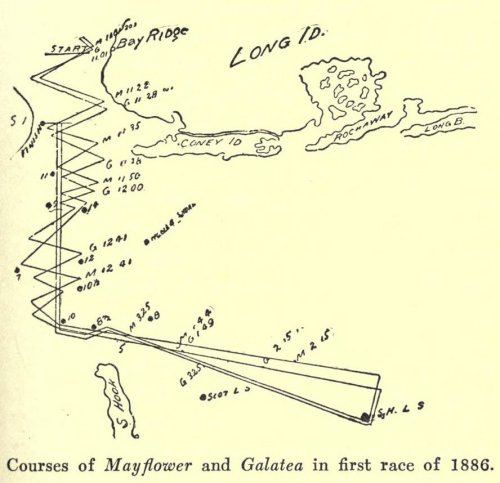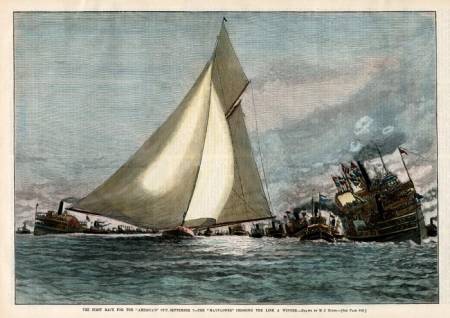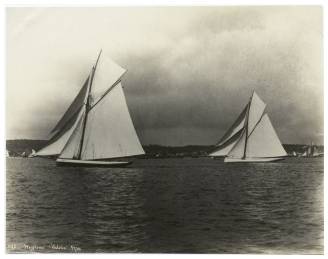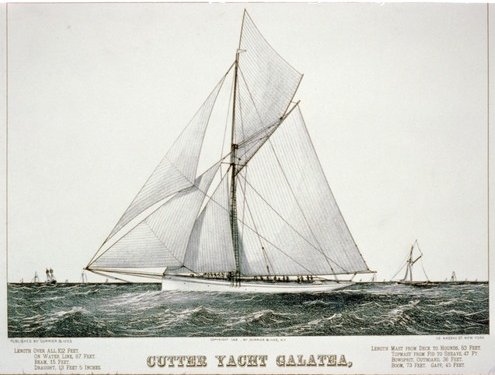Yves GARY Hits: 6720
Category: 1886 : CHALLENGE N°6
 The First Race, Tuesday, Sept. 7
The First Race, Tuesday, Sept. 7The course chosen for the first race was the regular one of the New York Yacht Club, starting from buoy 18, New York harbor, and the same as the one sailed over by the Puritan and Genesta in the "inside" race of the previous year. Interest in yachting in general, and in this event in particular, had been intensified by the races of 1885, and throughout the country news of the progress of the struggle was eagerly sought.
In Boston the enthusiasm of the previous season was unabated. At the scene of the contest there was the same dazzling picture as before. Speedy and costly steam yachts mingled with lowly craft of all descriptions. Sailing yachts, with huge spread of canvas, darted hither and thither to avoid the immense flotilla of tugs, steamers, and steam yachts, and the shores on both sides were black with people, who all day long gazed upon the grand marine spectacle.
The wind was from the south, compelling the yachts to beat down the Narrows, and was very light. As the prospect that it would increase in force was good,  the committee having charge of the race decided to start the boats, and the preparatory signal was given. Then there began the most skilful sailing for position of which yachtsmen are capable, and sharp tactics were resorted to.
the committee having charge of the race decided to start the boats, and the preparatory signal was given. Then there began the most skilful sailing for position of which yachtsmen are capable, and sharp tactics were resorted to.
The Galatea, however, held the most advantageous position, and was able to keep it until the signal for the start was given, when she shot over the line at 10:56:11; the Mayflower following at 10:56:12 o'clock. Both yachts crossed on the starboard tack, the Mayflower carrying her main-sail, club-top-sail, forestay-sail, jib and jib-top-sail, and the Galatea the same, except that her jib-top-sail was not set. The start was a magnificent one, and was accompanied by a deafening roar of cannon and shriek of whistles from the attendant fleet.
The Galatea being to windward, the Mayflower made an effort to prevent being blanketed, and soon crept a few feet to the front. The visitor, however, was pointing closer into the wind. As they neared the Bay Ridge shore, the sloop had a lead of two hundred feet, and, going about on the port tack, was nearly on even terms. The Galatea tacked immediately, and showed herself to be much quicker in stays. In standing toward the Staten Island shore, the cutter was jammed so closely into the wind that she moved heavily through the water, and the Mayflower was making a very perceptible gap between herself and her rival.
Both were affected by the strong flood-tide which was setting them to leeward, the Galatea suffering more than the Mayflower. At 11:03:30 the cutter's jib-top-sail was run up, but it did not prevent the Mayflower from still drawing away from her. As the yachts approached the Stapleton shore they found a large schooner anchored in their path. The Mayflower tried to weather it, and by luffing succeeded, but the English boat was obliged to go to leeward of it. Both kept close to the shore, the sloop going about at 11:13:30, and the cutter at 11:14:30 o'clock.
 On this stretch the Mayflower made a considerable gain. She did not attempt to sail so high into the wind, hut under skillful handling kept good headway and in the light wind did creditable work. Mr. Beavor-Webb held the tiller of the iron boat, and Captain Stone was at the Mayflower's wheel, while the assistance and suggestions of Messrs. Paine and Burgess were invaluable. The Galatea was being pinched hard to offset in windward work what the Mayflower was doing in outfooting her, and was fully a quarter of a mile astern when the latter tacked, at 11:22:20. Short tacks ensued, the Mayflower making fifteen and the Galatea sixteen from the start to buoy 10, the sloop then leading fully three-fourths of a mile. The Mayflower rounded buoy 8 at 1:01:51, and the Galatea at 1:07:07.
On this stretch the Mayflower made a considerable gain. She did not attempt to sail so high into the wind, hut under skillful handling kept good headway and in the light wind did creditable work. Mr. Beavor-Webb held the tiller of the iron boat, and Captain Stone was at the Mayflower's wheel, while the assistance and suggestions of Messrs. Paine and Burgess were invaluable. The Galatea was being pinched hard to offset in windward work what the Mayflower was doing in outfooting her, and was fully a quarter of a mile astern when the latter tacked, at 11:22:20. Short tacks ensued, the Mayflower making fifteen and the Galatea sixteen from the start to buoy 10, the sloop then leading fully three-fourths of a mile. The Mayflower rounded buoy 8 at 1:01:51, and the Galatea at 1:07:07.
From this point to the end of Sandy Hook the Galatea decreased the gap by holding better to windward against the tide than did the American boat. It was one long reach to the Sandy Hook Lightship, and the Mayflower's splendid sailing qualities added three minutes more to her advantage. She rounded the lightship on the starboard tack at 2:35:02, and her immense balloon jib-topsail was immediately broken out. The Galatea rounded at 2:44:13, and likewise set her balloon jib-top-sail, though by no means with the skill displayed by the Yankee crew.
In the reach back to the Hook, the sloop gained three minutes more, and passed buoy 8 at 3.34, followed by the Galatea at 3. 40 o'clock. With a slightly freshening wind, the boats began their run home before it, though the Boston boat did not set her spinnaker until she was within a mile of the finish. Five minutes before the cutter's spinnaker had been set, and both boats were bowling along at good speed, accompanied by the fleet of steam craft which crowded in on all sides. The Mayflower finished at 5:26:41, with a lead of one and one-half miles, and the Galatea at 5:39:21. Each received a salute, which continued for many minutes, steam-whistles and cannons sounding their loud acclaim.

 On Thursday, September 9, the day fixed for the second race, the weather was anything but favorable. There was a light rain, a fog, at times thick, and a moderate breeze east by north. The course was to be twenty miles to windward from the Scotland Lightship and return to the starting-point, and the yachts, anticipating bad weather, carried none of their flying kites. The Galatea had reefed her bowsprit and carried a No. 2 jib, working-top-sail, forestay-sail, and main-sail.
On Thursday, September 9, the day fixed for the second race, the weather was anything but favorable. There was a light rain, a fog, at times thick, and a moderate breeze east by north. The course was to be twenty miles to windward from the Scotland Lightship and return to the starting-point, and the yachts, anticipating bad weather, carried none of their flying kites. The Galatea had reefed her bowsprit and carried a No. 2 jib, working-top-sail, forestay-sail, and main-sail.
The start was made with the boats on the starboard tack, the Mayflower being a trifle to windward. The latter crossed at 11:30:30, and the Galatea at 11:30:32. The sloop slowly drew ahead, the wind meanwhile becoming lighter and lighter. Club-top-sails were set in place of working ones. The run out was uninteresting, it being almost certain that the race would not be finished. The fog had become so thick that it was impossible to judge of the relative positions of the boats, and the committee's boat, Luckenhach, had difficulty in finding the mark-boat.
At 4:26:22 the Mayflower rounded the mark, and, with spinnaker set to port, began her homeward run. The Galatea, failed to find the mark-boat, and turned her prow homeward, but did not thereby lose the race, as the Mayflower failed to reach the lightship within the time-limit. It was a day which could hardly be exceeded in discomfort and disappointment.
 The Cup races for 1886 came to an end on Saturday, September 11, when the Mayflower showed her heels to the English cutter, and won the race and the Cup. The run was twenty miles to leeward and return, starting from Scotland Lightship, and the wind at the start was from the north-west at the rate of twelve miles an hour. With spinnaker to port the Mayflower flew over the starting-line at 11:22:40 and immediately broke out her balloon jib-top-sail, the Galatea crossing at 11:24:10, and setting her spinnaker just after she crossed. The skill with which the sloop was handled had given her an advantage at the start. She was under the influence of her big canvas in going over the line, and started off at great speed. The Galatea followed directly in her wake, but, being over a minute behind, failed to take the wind out of the Mayflower's sails.
The Cup races for 1886 came to an end on Saturday, September 11, when the Mayflower showed her heels to the English cutter, and won the race and the Cup. The run was twenty miles to leeward and return, starting from Scotland Lightship, and the wind at the start was from the north-west at the rate of twelve miles an hour. With spinnaker to port the Mayflower flew over the starting-line at 11:22:40 and immediately broke out her balloon jib-top-sail, the Galatea crossing at 11:24:10, and setting her spinnaker just after she crossed. The skill with which the sloop was handled had given her an advantage at the start. She was under the influence of her big canvas in going over the line, and started off at great speed. The Galatea followed directly in her wake, but, being over a minute behind, failed to take the wind out of the Mayflower's sails.
In fact, the Boston sloop was constantly making the distance between them greater and greater. It was a steady gain, and as mile after mile was covered the lead showed the remarkable powers of the sloop. The Galatea's balloon jib-top-sail had not been set, but it was claimed that sailing before the wind was the strong point of the English boat. However, the sloop outfooted her all the time, and when the latter took in her spinnaker, a mile from the mark-boat, the cutter was a mile and a half astern.
The cutter rounded on the starboard tack, and began her windward work with main-sail, club-top-sail, forestay sail, jib, and jib-top-sail, and the Mayflower carried the same, excepting the jib-top-sail. Both stood off on this tack for a long time, during which the Mayflower kept working up to windward more than her rival, although the latter was then giving the best display of her abilities that had thus far been seen. At 4 o'clock the Mayflower had made but two tacks since leaving the mark-boat, and the Galatea had not gone about at all since rounding. Both were standing in close to the New Jersey' shore in the hope of getting more wind.
For an hour the breeze had been dying out, and the sloop was the greater loser. The Galatea then began to reduce the Mayflower's lead, which at one time had been over two miles ; but soon after 4 o'clock the racers became almost becalmed. A light breeze soon after sprang up, and the sloop was the first to get the advantage of it. The American boat was well up to windward and closer in shore, and here she ran away from the cutter, which could not get the benefit of the light off-shore breeze. At 5.30 o'clock, with the Mayflower about four miles from the finish, and the Galatea nearly the same distance astern of her, the wind again decreased. The yachts moved lazily along, and for a time it was doubtful if the race could be finished within the time-limit. It was a most unsatisfactory exhibition of yacht-racing; but the Mayflower finally reached the goal, with but eleven minutes of the seven hours to spare.
Former demonstrations in honor of the Boston sloop were repeated by the thousands of excursionists and the Mayflower was proclaimed the winner of the America's Cup.

Though beaten fairly, Lieutenant Henn felt that the weather was not suited to his boat and he challenged Mayflower to a match race off Marblehead in a real breeze. General Paine accepted and agreed to keep his boat in commission for the race until a certain date.  So Lieutenant Henn sailed Galatea to Marblehead and there the two yachts lay for ten whole days waiting for a breeze, which, with one of those rare freaks of nature, never came in sufficient strength to allow the race to be sailed. When the agreed time was up Mayflower was promptly hauled out, and the very next day it "piped up" a rattling breeze fit to try the worth of both yachts. Lieutenant Henn was disappointed, but General Paine felt that he had gone as far as he was called upon to do, and did not wait a day after the specified time had expired.
So Lieutenant Henn sailed Galatea to Marblehead and there the two yachts lay for ten whole days waiting for a breeze, which, with one of those rare freaks of nature, never came in sufficient strength to allow the race to be sailed. When the agreed time was up Mayflower was promptly hauled out, and the very next day it "piped up" a rattling breeze fit to try the worth of both yachts. Lieutenant Henn was disappointed, but General Paine felt that he had gone as far as he was called upon to do, and did not wait a day after the specified time had expired.
The following spring, Galatea being still in this country, a race was sailed between Mayflower and the English cutter in a strong breeze and Mayflower won easily. Lieutenant Henn was then satisfied, having had the test he wanted.
Just before the races of 1886 Lieutenant Henn issued a challenge to sail any American sloop or cutter to Bermuda and back to test the real abilities of the boats, but could get no takers, and there was a lot of talk about American “racing machines” being unfit to go to sea — much of which was true, though as regards Puritan and Mayflower they would have been capable of going there easily and comfortably, and probably in a shorter time than Galatea.
Lieutenant Henn and his cutter remained in this country until after the races with the Thistle the following year, 1887, and made many friends here.
